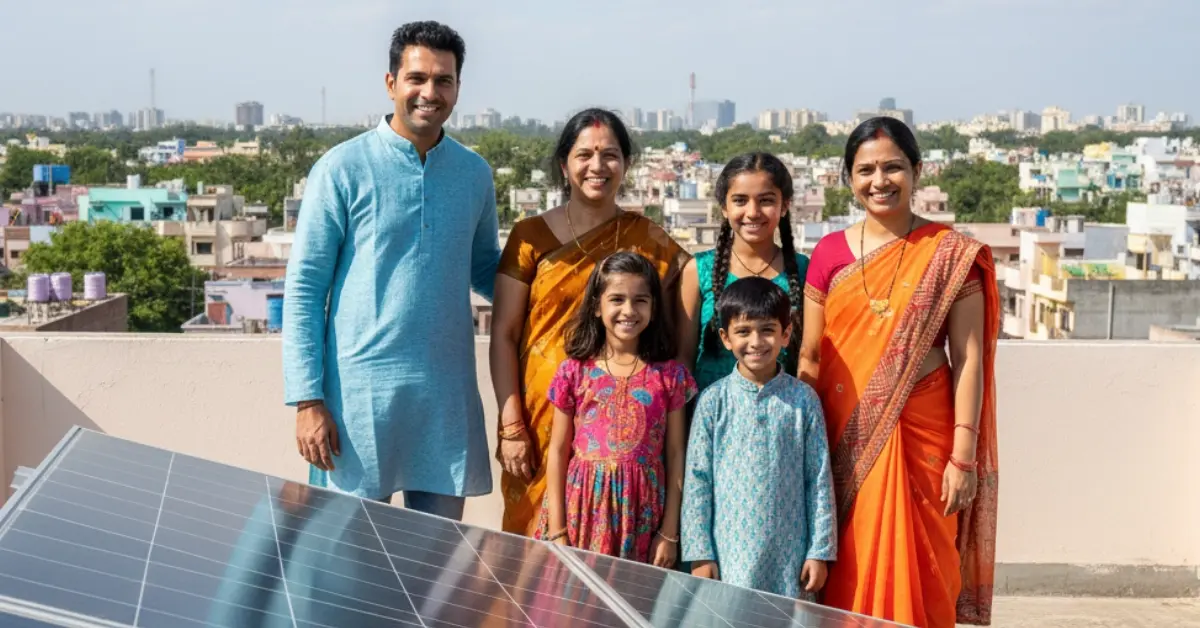India is moving fast towards clean and renewable energy. Among many options, solar rooftop systems are becoming the most popular choice for homes and businesses. A rooftop solar system allows you to generate electricity from sunlight using panels installed on your terrace. This not only reduces electricity bills but also supports the environment by cutting down carbon emissions.
In this blog, we will explain everything you need to know about solar rooftop systems, solar rooftop schemes, price lists, calculators, and the process of online application. By the end, you will understand how much it costs, how much you can save, and how to apply for subsidy benefits.
What is a Solar Rooftop System?
A solar rooftop system is a setup where solar panels are installed on the roof of your house, office, or building to generate electricity. The system mainly includes:
- Solar Panels: Capture sunlight and convert it into electricity.
- Inverter: Converts DC (direct current) from panels into AC (alternating current) used in homes.
- Mounting Structure: Frames that hold the panels firmly on the roof.
- Wires & Connectors: For transferring electricity.
- Monitoring Device: Helps you track generation and usage.
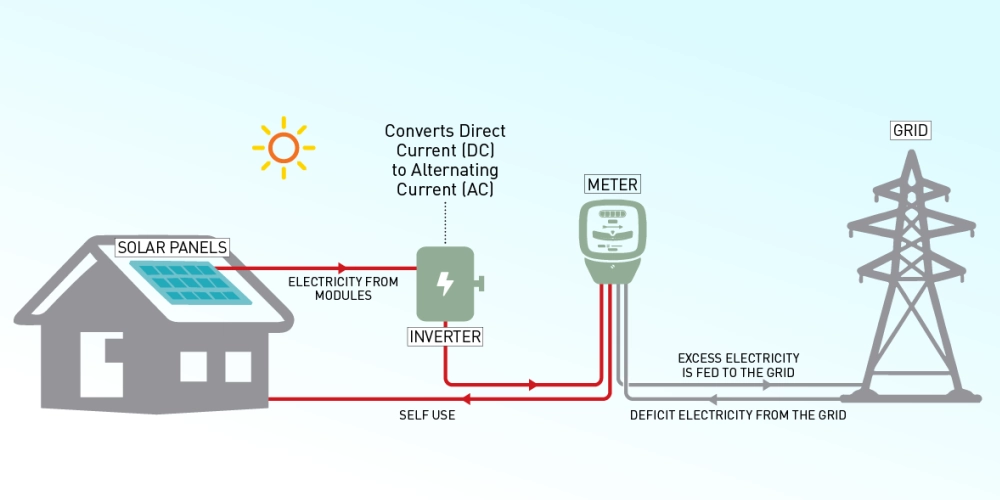
There are two main types:
- Grid-Connected System: Linked to the electricity grid with a facility for net metering.
- Off-Grid System: Works independently with batteries to store energy.
For most homes in India, a grid-connected solar rooftop is the best option.

Solar Rooftop Schemes in India
The Government of India has launched multiple solar rooftop schemes to make renewable energy affordable for common households. These schemes are managed by the Ministry of New and Renewable Energy (MNRE) along with state electricity boards (DISCOMs). The main aim is to reduce the cost of installing solar panels so that more families, societies, and small businesses can adopt solar power.
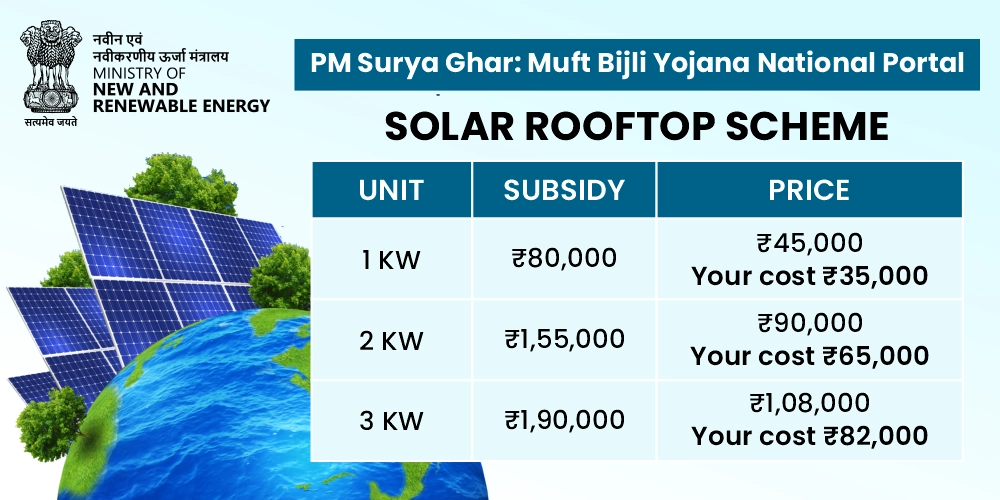
1. National Rooftop Solar Scheme (PM Surya Ghar Muft Bijli Yojana)
The central government provides financial assistance (subsidy) to residential consumers who install solar rooftop systems. The subsidy is directly credited to the consumer’s bank account once the system is installed and verified.
- Subsidy Rates (as of 2025):
- Up to 3 kW capacity: 40% subsidy on the benchmark cost.
- Above 3 kW and up to 10 kW: 20% subsidy on the benchmark cost.
- Housing societies or group housing projects: Subsidy is available for common facilities, like lifts, lights, and water pumps.
For example, if the benchmark cost of a 3kW solar rooftop system is ₹1.8 lakh, you may get around ₹70,000–₹75,000 subsidy, reducing your cost to nearly ₹1.1 lakh.
2. State Government Subsidies
Apart from central benefits, many states also provide extra subsidies or incentives. Some examples:
- Gujarat Solar Rooftop Scheme: One of the most successful, offering subsidies up to 40% for residential rooftop systems.
- Maharashtra Solar Subsidy: Offers additional benefits for residential users and has simplified the net metering process.
- Rajasthan Solar Subsidy: Provides attractive subsidies and easy financing options to encourage rural households.
- Delhi Solar Policy: Gives generation-based incentives (GBI), where consumers are paid for every unit of solar power generated.
Since policies vary from state to state, consumers should always check with their DISCOM (distribution company) for the latest scheme details.

3. Net Metering Policy
Another major benefit under the rooftop scheme is net metering. This allows you to connect your solar rooftop system with the state electricity grid.
- If your solar panels produce more electricity than your household uses, the extra units are exported to the grid.
- The DISCOM records this through a bi-directional meter.
- You receive credit for the exported units, which is adjusted in your next bill.
This means you can reduce your electricity bill even further, sometimes bringing it down to zero.
4. Benefits of the Solar Rooftop Scheme
Installing a solar rooftop system under the scheme has several long-term advantages:
- Lower Upfront Cost: Subsidies reduce the initial cost by 20–40%, making solar more affordable.
- Faster Return on Investment: With subsidies and savings on bills, most households recover their cost within 4–6 years.
- Lifetime Savings: Solar panels last 20–25 years, so after the payback period, electricity is almost free.
- Energy Independence: Reduced dependence on grid electricity and protection from rising power tariffs.
- Eco-Friendly Choice: Every 1 kW of solar reduces nearly 1.5 tonnes of CO₂ emissions per year.
How to Apply for Solar Rooftop Online
The government has made the process of installing solar panels easier by introducing the PM Surya Ghar: Muft Bijli Yojana National Portal (pmsuryaghar.gov.in). This online system allows you to apply for subsidies, track your application, and ensure your rooftop solar installation is officially registered with the DISCOM (electricity distribution company).
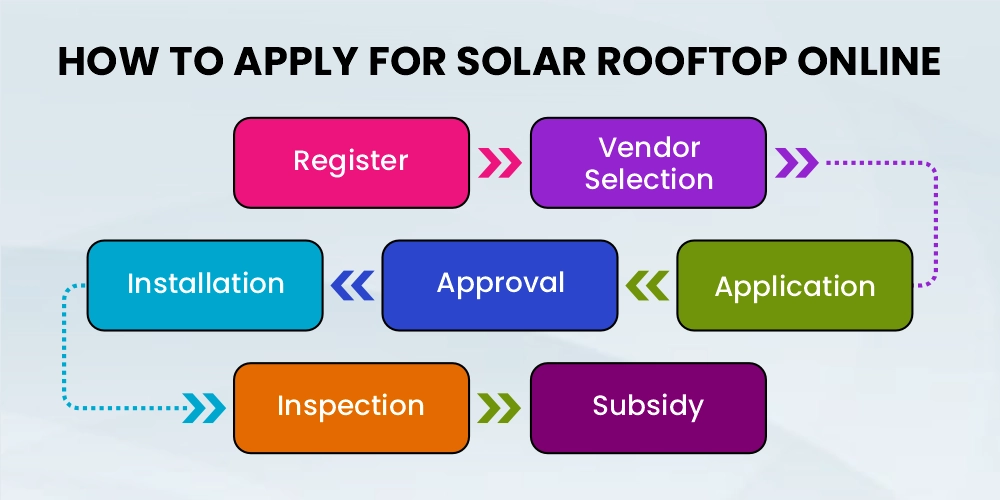
Step-by-Step Process to Apply
Step 1: Register on the Portal
- Go to the Solar Consumer Login Portal.
- Enter your mobile number and verify it with an OTP.
- After successful verification, fill in your name, state, district, and other details.
- Enter your email ID, verify with OTP, and save your profile.
At this stage, your profile is created on the solar rooftop portal.

Step 2: Vendor Selection
- A pop-up will ask if you want the vendor to fill out the application on your behalf.
- If yes, click ‘Yes’ and select the vendor.
- If you want to fill the form yourself, click ‘No’.
It is always recommended to choose an MNRE-approved vendor for smooth subsidy approval.
Step 3: Fill the Solar Rooftop Application
- Click on “Apply for Solar Rooftop”.
- Select your state, district, DISCOM, and consumer number.
- Click on “Fetch Details” to auto-fill some information.
- Review the details, fill in missing information, and submit the application.
Step 4: Feasibility Approval
- Once your application is submitted, the DISCOM reviews it for technical feasibility.
- After approval, you will receive confirmation.
- At this stage, you must select your vendor and submit your bank details (for subsidy transfer).
Step 5: Installation of Solar Rooftop System
- After feasibility approval, the vendor installs the plant.
- The vendor then submits the installation details to you (consumer).
- Once you verify, the vendor forwards these details to DISCOM.
Step 6: DISCOM Inspection & Commissioning
- DISCOM conducts a site inspection to check system quality and safety.
- After a successful inspection, DISCOM updates the details on the portal.
- Net meter installation is completed at this stage.
Step 7: Subsidy Redemption
- Once the DISCOM inspection is complete, the consumer redeems the subsidy on the portal.
- The National Programme Implementing Agency (NPIA) verifies and processes the request.
- The subsidy amount is credited directly to your bank account.
Documents Required for Solar Rooftop Application
To make the process smooth, keep the following documents ready:
- Aadhaar Card (mandatory for identity verification)
- Latest Electricity Bill (consumer number, load details)
- Bank Account Details (for subsidy credit)
- Property Ownership Proof (tax receipt, registry, or sale deed)
- Passport-size photograph (sometimes required by vendors)
Tips for a Smooth Application
- Always choose an MNRE-approved vendor. This ensures your system is subsidy-eligible and technically sound.
- Check your rooftop space. Generally, 1 kW requires 100 sq. ft. of area.
- Apply early. Subsidy approvals are limited and work on a first-come, first-served basis.
- Keep soft copies of documents. The portal requires uploading scanned copies in PDF/JPEG format.
- Track your application status. The portal provides regular updates on each stage.
Solar Rooftop Price in India (2025 Update)
The cost of a solar rooftop system in India depends on several factors:
- System Capacity (kW): Higher capacity means higher price, but better savings.
- Panel Type: Monocrystalline panels are costlier but more efficient, while polycrystalline panels are cheaper.
- Inverter Quality: Hybrid and string inverters are slightly costlier than basic models.
- Installation Charges: Depends on rooftop structure, wiring, and labour.
- State Policies: Some states offer additional subsidies or rebates.
Solar Rooftop Price List (Latest Benchmark Costs)
| Capacity | Price Before Subsidy | Price After Subsidy | Best For |
|---|---|---|---|
| 1 kW | ₹65,000 – ₹75,000 | ₹40,000 – ₹45,000 | Small homes (100 units/month) |
| 2 kW | ₹1,20,000 – ₹1,40,000 | ₹70,000 – ₹80,000 | Small families (200 units/month) |
| 3 kW | ₹1,80,000 – ₹2,10,000 | ₹1,10,000 – ₹1,30,000 | Medium families (300 units/month) |
| 5 kW | ₹3,00,000 – ₹3,50,000 | ₹2,00,000 – ₹2,20,000 | Large homes/shops (500 units/month) |
| 10 kW | ₹6,00,000 – ₹7,00,000 | ₹4,00,000 – ₹4,50,000 | Villas, societies, offices (1000+ units/month) |
Among these, the 3kW solar rooftop price is the most popular because it suits average Indian households with 300 units per month consumption.
Cost Breakdown of a 3kW Solar Rooftop System
Let’s take the example of a 3kW system (a standard for Indian homes).

- Solar Panels (3.5 kW rated): ₹1,20,000 – ₹1,30,000
- Inverter (Hybrid/String): ₹35,000 – ₹45,000
- Mounting Structures: ₹15,000 – ₹20,000
- Wires, Connectors & Protection Devices: ₹10,000 – ₹15,000
- Installation & Labor: ₹10,000 – ₹15,000
Total Cost (before subsidy): Around ₹1,90,000 – ₹2,10,000
Subsidy (40%): Around ₹75,000
Final Cost (after subsidy): ₹1,15,000 – ₹1,25,000
Return on Investment (ROI) for Different Capacities
- 1 kW System: Saves ~₹800–₹1,000 per month. Payback in 4–5 years.
- 2 kW System: Saves ~₹1,500–₹1,800 per month. Payback in 4–5 years.
- 3 kW System: Saves ~₹2,000–₹2,500 per month. Payback in 4–5 years.
- 5 kW System: Saves ~₹4,000–₹5,000 per month. Payback in 5–6 years.
- 10 kW System: Saves ~₹8,000–₹10,000 per month. Payback in 6–7 years.
After the payback period, the electricity you generate is practically free for the remaining life of the panels (20–25 years).
Why Solar Rooftop Prices Are Falling in India
- Government Subsidy Support: Central and state schemes reduce the burden.
- Competition Among Vendors: Many new companies have entered the solar market.
- Technology Improvement: More efficient solar panels and inverters reduce per-unit cost.
- Economies of Scale: As demand increases, manufacturing and installation costs drop.
Key Takeaway: In 2025, the solar rooftop price in India has become affordable for common households. With subsidies and rising electricity tariffs, investing in solar is one of the best financial decisions for long-term savings.
Solar Rooftop Calculator – Estimate Your Savings
Before installing a solar rooftop system, most families ask one important question: “How much will it cost, and how much will I save every month?”
This is where the solar rooftop calculator comes in. It is an online tool provided by the government and DISCOMs that helps you estimate:

- The right solar capacity (kW) for your home.
- The installation cost (before and after subsidy).
- Monthly electricity savings.
- Payback period (time to recover your investment).
You can use the official calculator on the National Portal for Rooftop Solar (solarrooftop.gov.in) or your state electricity board’s website.
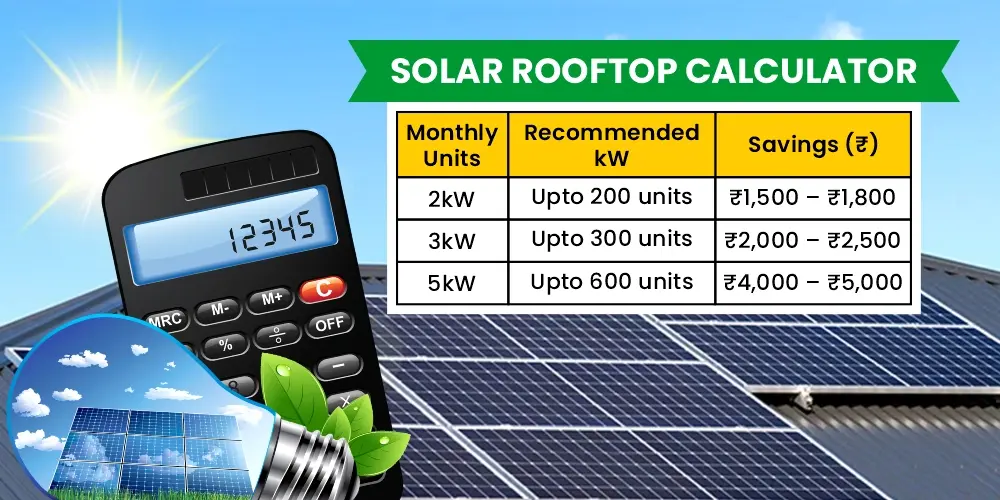
How Does the Solar Rooftop Calculator Work?
The calculator requires a few basic inputs:
- Monthly Electricity Consumption (Units): How much power you use every month.
- State & DISCOM: Electricity tariff varies from state to state.
- Available Rooftop Area: Roughly 100 sq. ft. per 1 kW is needed.
- System Capacity (kW): Chosen based on your usage.
Once you enter these details, the calculator shows:
- System Size Recommendation (in kW).
- Approximate Cost before subsidy.
- Subsidy Amount available.
- Final Cost after subsidy.
- Monthly Savings on your electricity bill.
Example 1: 2kW Solar Rooftop System
- Monthly Usage: 200 units
- Benchmark Cost: ₹1,30,000 (approx.)
- Subsidy (40%): ₹52,000
- Final Cost After Subsidy: ₹78,000
- Monthly Savings: ₹1,500 – ₹1,800 (depends on tariff)
- Payback Period: 4–5 years
- Lifetime Savings (25 years): ₹4–5 lakh
This is suitable for small households (1–2 BHK).
Example 2: 3kW Solar Rooftop System
- Monthly Usage: 300 units
- Benchmark Cost: ₹1,90,000 (approx.)
- Subsidy (40%): ₹75,000
- Final Cost After Subsidy: ₹1,15,000
- Monthly Savings: ₹2,000 – ₹2,500
- Payback Period: 4–5 years
- Lifetime Savings (25 years): ₹6–7 lakh
This is the most popular choice for Indian families.

Example 3: 5kW Solar Rooftop System
- Monthly Usage: 500–600 units
- Benchmark Cost: ₹3,20,000 (approx.)
- Subsidy (20%): ₹64,000
- Final Cost After Subsidy: ₹2,56,000
- Monthly Savings: ₹4,000 – ₹5,000
- Payback Period: 5–6 years
- Lifetime Savings (25 years): ₹10–12 lakh
This is ideal for large homes, shops, or small offices.
Why Use the Calculator Before Applying?
- Helps you choose the right system capacity (don’t overspend).
- Gives a clear idea of costs and savings before investment.
- Ensures you can compare prices from different vendors.
- Provides confidence when applying for a solar rooftop scheme online.
Home Solar Rooftop Installation Guide
Installing rooftop solar panels for the home is simple if planned properly.
- Best Capacity for Homes: Usually 2kW to 5kW.
- Space Required: Around 100 sq. ft. per kW.
- Installation Time: 5 to 10 days.
- Maintenance: Panels need cleaning twice a month, and inverter service every 2–3 years.
Popular brands for home solar rooftops in India include Tata Power Solar, Luminous, Havells, Adani Solar, and Waaree.
Government Subsidy & Financing Options
The solar rooftop scheme provides a direct subsidy:
- Up to 40% for systems up to 3kW.
- 20% subsidy for 3kW to 10kW.
- For housing societies, subsidy is also available based on capacity.
Financing Options:
- Bank Loans & EMI: Many banks offer easy financing.
- Net Metering Credits: Save further by exporting extra power.
- Payback Guarantee: After 4–6 years, electricity is nearly free for the system’s lifespan (20–25 years).
Conclusion
The demand for solar rooftop systems in India is rising rapidly. With falling prices, strong government support, and attractive subsidies, this is the right time to apply for solar rooftop installation. A 3kW system is ideal for most Indian households and offers excellent returns.

By using a solar rooftop calculator, checking the price list, and applying through the online portal, you can enjoy big savings and contribute to a greener future.
So, if you want to reduce electricity bills and secure your energy needs, now is the time to go solar!
Also Read: Earn Money Online Without Investment
FAQs on Solar Rooftop
Q1. What is the average solar rooftop price in India?
Ans: The price is around ₹65,000 to ₹75,000 per kW before subsidy, and ₹40,000–₹45,000 after subsidy.
Q2. How much does a 3kW solar rooftop system cost?
Ans: Around ₹1.8–₹2.1 lakh before subsidy, and ₹1.1–₹1.3 lakh after subsidy.

Q3. How to apply for solar rooftop subsidy?
Ans: You can apply online through the National Portal for Rooftop Solar (solarrooftop.gov.in).
Q4. Which is the best rooftop solar system for homes?
Ans: Grid-connected systems with net metering are best for Indian homes.
Q5. How long does it take to recover the cost?
Ans: The payback period is usually 4–6 years, after which electricity is almost free.

